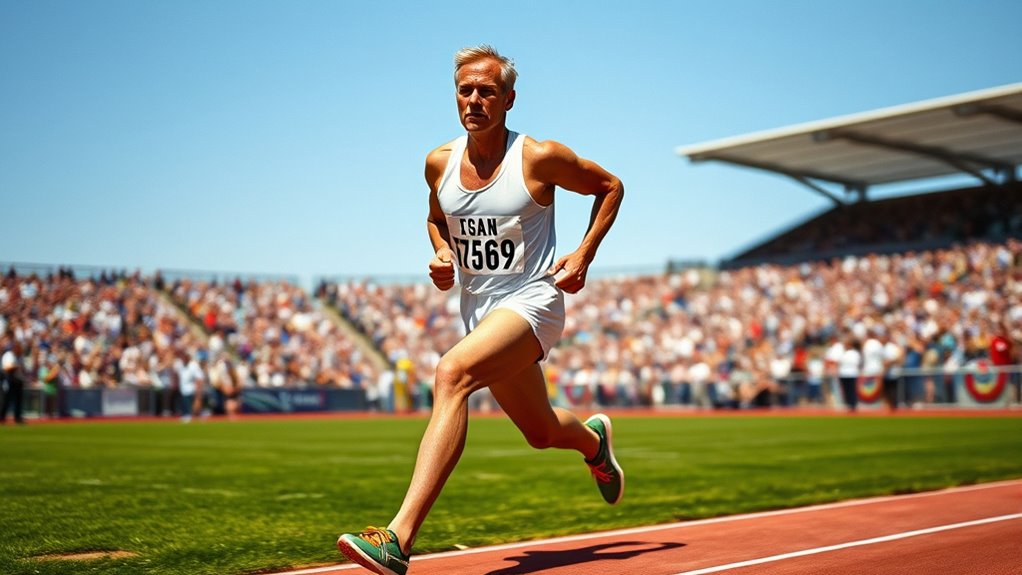To break the four-minute mile, Roger Bannister used innovative training techniques like interval and tempo runs, along with mental strategies such as visualization and race planning. He also wore lightweight, supportive shoes to reduce fatigue and improve efficiency. His disciplined approach combined physical, mental, and equipment strategies, proving that human limits are often psychological. If you want to discover how Bannister’s mindset and preparation led to his historic achievement, there’s more to uncover.
Key Takeaways
- Roger Bannister trained with interval runs, tempo sessions, and mental visualization to build endurance and focus.
- He developed a strategic race plan, pacing himself to break the four-minute barrier.
- Bannister used lightweight, supportive shoes to enhance performance and reduce fatigue.
- Mental resilience and psychological preparation helped him overcome the belief that the mile couldn’t be run in under four minutes.
- His groundbreaking achievement proved that innovation in training, gear, and mindset can surpass perceived physical limits.

On May 6, 1954, Roger Bannister made history by becoming the first person to run a mile in under four minutes, a feat many believed impossible at the time. If you’re fascinated by how he achieved this groundbreaking milestone, understanding his training techniques and the athletic footwear he used is essential. Bannister’s success wasn’t just about talent; it was about meticulous preparation and innovation in running gear.
Bannister adopted a rigorous and strategic approach to his training techniques. He focused on interval training, which involved running short, intense bursts followed by recovery periods. This method helped improve his speed and stamina considerably. He also incorporated tempo runs to build endurance and mental resilience. Bannister knew that mental preparation mattered just as much as physical conditioning, so he worked on visualization and race strategy. His training was disciplined, emphasizing consistency and gradual progress, rather than overexertion. This approach allowed him to push his limits safely and steadily, setting the stage for his historic run.
Bannister’s disciplined training with interval and tempo runs built endurance and mental resilience for his historic run.
Equally important was the footwear Bannister wore during his record attempt. In the 1950s, athletic footwear was evolving, but it still lagged behind today’s advanced designs. Bannister used lightweight, well-cushioned shoes that provided support without adding unnecessary weight. These shoes were vital because they minimized fatigue and allowed him to maintain ideal running form throughout the race. The emphasis on proper footwear meant fewer injuries and better efficiency, giving Bannister an edge. While modern runners benefit from high-tech materials, Bannister’s shoes represented the best available at the time, proving that even then, the right gear could make a difference. Ensuring optimal toilet flushing efficiency might not seem related, but just as proper footwear supported Bannister’s performance, choosing the right flushing mechanism can improve bathroom efficiency and conserve resources.
It’s inspiring to see how Bannister combined innovative training techniques with suitable athletic footwear to defy the odds. His preparation wasn’t just about running more miles; it was about running smarter. By refining his workouts and choosing gear that supported his body, he broke a psychological barrier that had stood for decades. If you’re interested in breaking your own barriers, studying Bannister’s approach reminds you that discipline, strategy, and the right equipment are key. His achievement taught the world that limits are often mental rather than physical, and that with careful planning, seemingly impossible goals can become reality.
In the end, Bannister’s historic run was a perfect storm of proper training, innovative gear, and mental toughness. It’s a testament to how careful preparation and belief in oneself can lead to extraordinary accomplishments.
Frequently Asked Questions
What Was Roger Bannister’s Training Regimen Like?
You should know that Roger Bannister’s training regimen focused on intensive training strategies like interval runs, speed work, and gradual mileage increases. He also followed careful dietary plans to guarantee peak energy and recovery. Bannister balanced his workouts with rest and mental preparation, emphasizing consistency and discipline. His approach combined physical conditioning and nutrition, helping him achieve the historic four-minute mile and inspiring future runners worldwide.
How Did Bannister’s Breaking the Record Influence Future Athletes?
You see, Bannister’s record-breaking feat set the stage for future athletes, fueling their athletic inspiration and pushing boundaries. His achievement showed that seemingly impossible goals could be achieved with determination and innovation. This record-breaking legacy motivated runners to aim higher, break their own limits, and challenge the status quo. As a result, athletes today continue to chase greatness, knowing that one breakthrough can inspire a new era of excellence.
Were There Any Technological Aids Used During Bannister’s Run?
You’ll find that during Bannister’s run, there were no advanced wearable technology or specialized track surfaces like today’s. He relied on his training, mental toughness, and the track’s good condition. Modern athletes benefit from wearable tech and optimized track surfaces, but Bannister’s achievement came purely from human effort and determination. His historic run inspired innovations and motivated future runners, showing that groundbreaking performances can be achieved without high-tech aids.
Did Bannister Face Any Injuries or Setbacks Before His Record?
You’ll find that Bannister did face some injury struggles and training setbacks before his record-breaking run. These challenges temporarily slowed his progress, making him question his readiness. Despite this, he stayed committed and adjusted his training. His perseverance paid off, allowing him to overcome those setbacks and push through to break the four-minute mile, proving that resilience and focus are key to overcoming injury struggles in pursuit of greatness.
What Was the Global Reaction Immediately After Bannister’s Achievement?
You’d notice that the public reaction was one of awe and excitement, as Bannister’s achievement shattered long-standing beliefs. The media coverage exploded, with headlines celebrating his incredible feat and highlighting the significance of breaking the four-minute barrier. People around the world viewed it as a symbol of human potential, inspiring countless athletes. Bannister’s record captivated audiences instantly, elevating his status to a legendary figure in sports history.
Conclusion
You see, Bannister’s run isn’t just about breaking a record; it’s about breaking barriers within yourself. Imagine the track as a wall of doubt and fear—his swift, confident stride smashing right through it. That four-minute mile symbolizes what’s possible when you push beyond limits. His victory reminds you that with determination, you can shatter your own barriers, turning the impossible into a shining symbol of perseverance and triumph on the path ahead.









